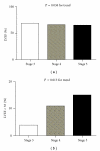Stepwise increases in left ventricular mass index and decreases in left ventricular ejection fraction correspond with the stages of chronic kidney disease in diabetes patients
- PMID: 21860616
- PMCID: PMC3155789
- DOI: 10.1155/2012/789325
Stepwise increases in left ventricular mass index and decreases in left ventricular ejection fraction correspond with the stages of chronic kidney disease in diabetes patients
Abstract
Aims: Patients with diabetic nephropathy are reported to have a high prevalence of left ventricular structural and functional abnormalities. This study was designed to assess the determinants of left ventricular mass index (LVMI) and left ventricular ejection fraction (LVEF) in diabetic patients at various stages of chronic kidney disease (CKD).
Methods: This cross-sectional study enrolled 285 diabetic patients with CKD stages 3 to 5 from our outpatient department of internal medicine. Clinical and echocardiographic parameters were compared and analyzed.
Results: We found a significant stepwise increase in LVMI (P < 0.001), LVH (P < 0.001), and LVEF <55% (P = 0.013) and a stepwise decrease in LVEF (P = 0.038) corresponding to advance in CKD stages.
Conclusions: Our findings suggest that increases in LVMI and decreases in LVEF coincide with advances in CKD stages in patients with diabetes.
Figures


Similar articles
-
Significant correlation between ratio of brachial pre-ejection period to ejection time and left ventricular ejection fraction and mass index in patients with chronic kidney disease.Nephrol Dial Transplant. 2011 Jun;26(6):1895-902. doi: 10.1093/ndt/gfq639. Epub 2010 Oct 8. Nephrol Dial Transplant. 2011. PMID: 20935012
-
Left ventricular hypertrophy in non-insulin-dependent diabetic patients with and without diabetic nephropathy.Diabet Med. 1997 Jul;14(7):538-46. doi: 10.1002/(SICI)1096-9136(199707)14:7<538::AID-DIA415>3.0.CO;2-I. Diabet Med. 1997. PMID: 9223391
-
Echocardiographic changes following hemodialysis initiation in patients with advanced chronic kidney disease and symptomatic heart failure with reduced ejection fraction.Clin Nephrol. 2012 May;77(5):366-75. doi: 10.5414/cn107169. Clin Nephrol. 2012. PMID: 22551882
-
Angiotensin receptor antagonist regresses left ventricular hypertrophy associated with diabetic nephropathy in dialysis patients.J Cardiovasc Pharmacol. 2004 Mar;43(3):380-6. doi: 10.1097/00005344-200403000-00008. J Cardiovasc Pharmacol. 2004. PMID: 15076221 Clinical Trial.
-
Determinants of left ventricular mass and hypertrophy in hemodialysis patients assessed by cardiac magnetic resonance imaging.Clin J Am Soc Nephrol. 2009 Sep;4(9):1477-1483. doi: 10.2215/CJN.03350509. Clin J Am Soc Nephrol. 2009. PMID: 19713289 Free PMC article.
Cited by
-
P wave dispersion and maximum P wave duration are associated with renal outcomes in chronic kidney disease.PLoS One. 2014 Jul 9;9(7):e101962. doi: 10.1371/journal.pone.0101962. eCollection 2014. PLoS One. 2014. PMID: 25006682 Free PMC article.
-
Glomerular Filtration Dysfunction is Associated with Cardiac Adverse Remodeling in Menopausal Diabetic Chinese Women.Clin Interv Aging. 2021 Apr 14;16:603-609. doi: 10.2147/CIA.S306342. eCollection 2021. Clin Interv Aging. 2021. PMID: 33883887 Free PMC article.
-
Reduction of left ventricular ejection fraction after 12-month follow-up in hemodialysis patients.J Renal Inj Prev. 2016 Feb 24;5(1):8-11. doi: 10.15171/jrip.2016.02. eCollection 2016. J Renal Inj Prev. 2016. PMID: 27069961 Free PMC article.
-
Utility of traditional circulating and imaging-based cardiac biomarkers in patients with predialysis CKD.Clin J Am Soc Nephrol. 2015 Mar 6;10(3):515-29. doi: 10.2215/CJN.03600414. Epub 2014 Nov 17. Clin J Am Soc Nephrol. 2015. PMID: 25403922 Free PMC article. Review.
-
Risk for subsequent hypertension and cardiovascular disease after living kidney donation: is it clinically relevant?Clin Kidney J. 2021 Dec 13;15(4):644-656. doi: 10.1093/ckj/sfab271. eCollection 2022 Apr. Clin Kidney J. 2021. PMID: 35371443 Free PMC article. Review.
References
-
- Ritz E. Diabetic nephropathy. Saudi Journal of Kidney Diseases and Transplantation. 2006;17(4):481–490. - PubMed
-
- Ritz E. Heart and kidney: fatal twins? American Journal of Medicine. 2006;119(5) supplement 1:S31–S39. - PubMed
-
- Levin A, Singer J, Thompson CR, Ross H, Lewis M. Prevalent left ventricular hypertrophy in the predialysis population: identifying opportunities for intervention. American Journal of Kidney Diseases. 1996;27(3):347–354. - PubMed
-
- Levin A, Thompson CR, Ethie J, et al. Left ventricular mass index increase in early renal disease: impact of decline in hemoglobin. American Journal of Kidney Diseases. 1999;34(1):125–134. - PubMed
-
- Veves A, Akbari CM, Primavera J, et al. Endothelial dysfunction and the expression of endothelial nitric oxide synthetase in diabetic neuropathy, vascular disease, and foot ulceration. Diabetes. 1998;47(3):457–463. - PubMed
Publication types
MeSH terms
LinkOut - more resources
Full Text Sources
Medical
